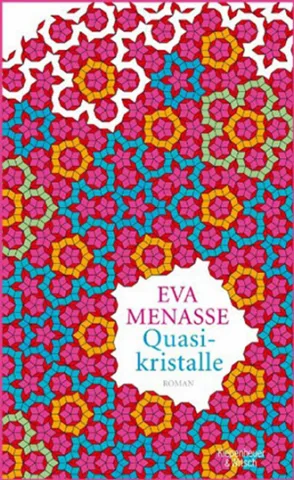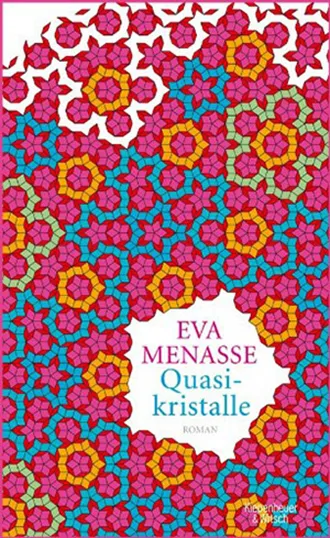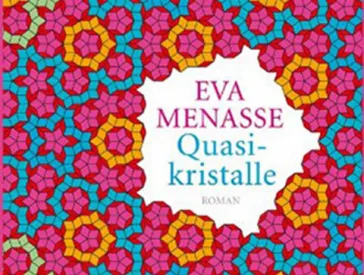„Quasikristalle“
Eva Menasses Roman als Anlass für ein Gespräch über jüdische Fragen, weibliche Lebensentwürfe und Erwartungen an Literatur
Im Zentrum des Romans Quasikristalle (2013) von Eva Menasse steht Xane Molin, eine zunächst junge, dann älter werdende Frau, die versucht, ihren Beruf mit dem Wunsch unter einen Hut zu bringen, für die eigenen Kinder da zu sein und ein gutes Leben zu führen. Unser von 2012 bis 2019 bestehender Museumblog Blogerim wurde 2013 von drei Frauen redigiert, die zwischen Mitte dreißig und vierzig Jahre alt waren, Literaturwissenschaften studiert haben und ebenfalls versuchten, berufliches Engagement, ihre Interessen und ihr Privatleben aufeinander abzustimmen. Quasikristalle wirft in jedem Kapitel einen anderen Blick auf Xanes Leben und die Blog-Redakteurinnen im Gespräch auf den Roman.
Mirjam Bitter: Ich habe unsere Literatur-Blogserie geschlechtergerechter in „junge jüdische Autorinnen und Autoren“ umbenannt. Dabei ist mir allerdings aufgefallen, dass wir bisher nur männliche Autoren besprochen haben. Wie wär’s, als nächstes eine Autorin vorzustellen?
Mirjam Wenzel: Ich lese gerade Quasikristalle von Eva Menasse und ich frage mich, was ihr wohl zu dem Buch sagt?
Naomi Lubrich: Tja… Eva Menasse ist eine angesagte Autorin, nur weiß ich nicht, ob es ergiebig ist, Quasikristalle in unserem Blog unter jüdischen Aspekten zu betrachten. Judentum ist im Roman nur an wenigen Stellen Thema und dort ausschließlich auf die Bewältigung der Vergangenheit bezogen. Mich hat gewundert, dass im Roman ein gelebtes Judentum, zum Beispiel im Sinne eines modernen Gemeindelebens oder die Begehung der jüdischen Feste, nicht stattfindet. Versteht ihr diesen Lebensentwurf als eine zutreffende Beschreibung des heutigen deutsch-europäischen Judentums?
Mirjam Bitter: Man muss den Roman ja nicht gleich als paradigmatisch für ‚das‘ jüdische Leben im deutschsprachigen Europa lesen. Das Jüdische ist nur eine von verschiedenen thematisierten Facetten der Hauptfigur Xane. Bei ihr scheint sich die Frage nach jüdischer Identität tatsächlich vor allem an der Verfolgungsvergangenheit des Vaters aufzuhängen. Dass Xane durch ihre Auseinandersetzung mit der Verfolgungsgeschichte des Vaters „fortan als ‚jüdische Intellektuelle‘ galt“, wird dabei als Fremdwahrnehmung thematisiert.
Zugleich kritisiert der Roman, wenn immer nur von toten Jüdinnen und Juden geredet und die Gegenwart wegen Geschichtsversessenheit ausgeblendet wird:
„Was sind die schönen, gebildeten, toten Juden doch für ein Verlust! Die lebenden dagegen sind meistens recht schwierig.“
Da ist es eigentlich inkonsequent, dass er den heutigen vielfältigen Weisen, Jude oder Jüdin zu sein, selbst recht wenig Aufmerksamkeit schenkt. Uninteressant ist das Buch aus jüdischer Perspektive trotzdem nicht und literarisch hat es überdies seine Qualitäten: Eva Menasse beherrscht die Form der kürzeren Erzählung perfekt (das hat sie schon in Lässliche Todsünden [2009] bewiesen) und auch hier fand ich einige Kapitel äußerst gelungen und habe das Buch zwischendurch kaum weglegen können.
Mirjam Wenzel: Ich kann eure Kritik verstehen und möchte euch zugleich widersprechen: Das Thema jüdische Identität wird tatsächlich vor allem im zweiten Kapitel, der Gruppenreise in das Konzentrations- und Vernichtungslager Auschwitz, verhandelt. Also mit einem – zugleich konkreten wie überdeterminierten – Bezug zum ikonischen Ort der Vernichtung. In diesem Kapitel, in dem der Erzähler (Bernays) die Hauptfigur (Xane) und sich selbst zum „klassischen Fall einer halbjüdischen Doppelhelix“
erklärt, spielt aber auch die abwesende Geliebte Pauline eine zentrale Rolle. Ihr scheint an jüdischem Gemeindeleben durchaus gelegen zu sein – zumindest steht bei ihrer Tochter die Bat Mitzwa an. Je mehr sich Bernays von Xane angezogen fühlt, desto häufiger meldet sich auch Pauline telefonisch zu Wort – ohne jedoch Gehör zu finden. Insofern reflektiert der Roman die Verstrickung in die Doppelhelix explizit als Abwenden des Erzählers von der Schilderung entschieden jüdischer Lebensweisen.
Alle jüdischen Figuren des zweiten Kapitels werden als Personen dargestellt, deren Biografie maßgeblich von Auschwitz geprägt wird. Dies scheint mir symptomatisch für das Porträt zu sein, das Eva Menasse von muttersprachlich deutschen Juden und nicht etwa von Juden in Deutschland und Österreich zeichnet. Ihre Diagnose zielt also nur auf einen – immer kleiner werdenden – Personenkreis innerhalb der heutigen jüdischen Gemeinden, deren Strukturen, Entwicklungen und Eigenarten ansonsten keinerlei Erwähnung finden. Im Unterschied zu euch gefällt mir, dass der Roman nicht versucht, die Vielfalt jüdischer Lebenswirklichkeiten zu repräsentieren, nur weil seine zentrale Bezugsperson einen jüdischen Vater hat. Er entzieht sich damit nämlich en passant begrifflichen Bestimmungen wie ‚jüdische Literatur‘ und den mit diesen verbundenen Erwartungen.
Naomi Lubrich: Wenn ich deine Gedanken zum ‚überdeterminierten Bezug‘ der Figuren zu Auschwitz weiterführe, sind die Implikationen des Vergangenheitsbewältigungsprozesses nicht ausschließlich pessimistisch zu deuten. Immerhin treibt die Auseinandersetzung mit der jüdischen Identität Xane und Bernays zur beruflichen Erfüllung – Xane zu ihrer Politkunst und Bernays zur akademischen Forschung – und wird zur motorisierenden Kraft eines entsprechenden gesellschaftlichen Diskurses. Kunst und Wissenschaft entwickeln sich für beide Figuren zu einer virtuellen Ersatzgemeinde, die versöhnlich wirkt. Diese Vorstellung lässt das Buch tatsächlich ergiebig erscheinen. Wer von uns schreibt denn nun die Rezension?
Mirjam Wenzel: Ich muss jetzt los zu meinem nächsten Meeting. Ich würde vorschlagen, wir überlegen alle noch einmal, wer von uns Lust dazu hat, und stimmen uns dann erneut ab, okay?
Drei Tage später ...
Naomi Lubrich: Wir haben uns ja kürzlich über Eva Menasses Roman Quasikristalle unterhalten, aber noch nicht geklärt, wer von uns das Buch jetzt für Blogerim rezensiert. Ich persönlich hätte schon Lust dazu und einiges zu sagen, sowohl zur jüdischen Thematik wie auch übrigens zu Menasses Frauenbild, das ich unrealistisch und ideell überzeichnet fand. Xane ist regelrecht die Karikatur einer „Powerfrau“: eine fürsorgliche Mutter und Stiefmutter von drei zum Teil schwererziehbaren Kindern, gleichzeitig eine tonangebende Filmekünstlerin und einflussreiche Intellektuelle. Währenddessen führt sie eine harmonisch-komplikationsfreie Ehe, lässt sich aber auch auf zahlreiche weitere Männer ein ...
Mirjam Bitter: Ich fand die Idealisierung von Menasses Heldin ebenfalls zunehmend schade. In den ersten Kapiteln schwankte die Beschreibung der Hauptfigur noch zwischen Durchschnittlichkeit und Mystifizierung. Es wurde auch deutlich, dass alle Aussagen über sie von der jeweiligen Figurenperspektive des Kapitels geprägt werden. Aber je mehr der Text fortschreitet, desto mehr verschenkt er das Potential seiner Konstruktion und seines Titels. Statt eines Quasikristalls mit scheinbar ungeordneter Struktur läuft es doch immer mehr auf ein kristallklares und idealisiertes Bild von Xane heraus. Zwar fallen die Bewertungen von Xanes Leben durch die verschiedenen Erzählerstimmen unterschiedlich aus, aber diejenigen, die sich negativ äußern, entlarven sich damit vor allem selbst (die Stieftochter als pubertäres Monster, Xanes Angestellter als männlicher Selbstüberschätzer und Krystyna als nachtragende, Hilfe verweigernde Freundin).
Auch dass Xane im siebten Kapitel plötzlich selbst spricht, fand ich schade. Es hätte mich mehr überzeugt, sich das Bild der Figur nur aus den Außenperspektiven zusammenreimen zu müssen. Aber vielleicht war die Ich-Perspektive notwendig, um das Thema postnatale Depression und weibliche Midlife-Crises zu erzählen? Vielleicht ist sogar die idealisierende Figurenzeichnung letztlich eine Hilfe, solche Themen wie Fehlgeburten aufzugreifen, ohne ein larmoyantes Buch zu schreiben? Ob es ein Ideal ist, im Alter zwar nochmal einen Typen abzukriegen, sich aber mit der besten Freundin zerstritten zu haben, steht außerdem in Frage.
Mirjam Wenzel: Ich teile eure Kritik nicht, dass die Figur unrealistisch konzipiert sei oder idealisiert dargestellt werde. Meiner Ansicht nach kommt dieser Eindruck durch die Konstitution des Romans, also die verschiedenen Perspektiven zu Stande, unter denen die Hauptfigur in den Blick genommen wird. Denn diese Perspektiven basieren – wie etwa die Metapher des Spiegels unterstreicht – durchaus auf voyeuristischen Zuschreibungen und Projektionen. Dass Xane nach dem misslungenen Liebesabenteuer selbst zu Wort kommt, um ihrerseits das Gelingen des Liebesabenteuers ihrer Freundin zu antizipieren, stellt einen Bruch in der Konstitution des Romans dar, der genau auf eben diesen Zusammenhang zwischen Erzählung, Projektion und Begehren hinweist. Es ist eben diese Trias, die den Roman einen Bogen von der ersten bis zur letzten Liebe schlagen lässt und die einzelnen Kapitel im Innersten zusammenhält.
Was unsere Rezension angeht: Wie wäre es, wenn wir einfach unser Gespräch verschriftlichen und im Blog veröffentlichen? Mit etwas Glück führen unsere Leserinnen und Leser das Gespräch dann im Kommentarmodus fort.
Literaturangabe
Eva Menasse, Quasikristalle, Köln: Kiepenheuer & Witsch 2013.
Zitierempfehlung:
Mirjam Bitter, Naomi Lubrich, Mirjam Wenzel (2013), „Quasikristalle“. Eva Menasses Roman als Anlass für ein Gespräch über jüdische Fragen, weibliche Lebensentwürfe und Erwartungen an Literatur.
URL: www.jmberlin.de/node/6157
Rezensionen: Junge jüdische Autor*innen (2)



 X
X

 X
X

